
views
Liver transplantation is a surgical procedure that involves replacing a damaged or diseased liver with a healthy liver from a donor. It is typically performed in individuals with end-stage liver disease or liver failure. The life-saving intervention is a complex procedure and requires careful planning, preparation, and post-operative care. It can have a profound impact on the quality of life for those who undergo it. While there are risks associated with any major surgery, liver transplantation has a high success rate and can provide a second chance at life for those in need.
Types:
According to the US National Institute of Diabetes and Digestive and Kidney Diseases, there are two types of Liver Transplant. The majority of livers used in transplants come from deceased donors, who are individuals that have recently died. During a deceased donor transplant, your damaged or diseased liver is taken out by surgeons and replaced with the liver from the deceased donor.
In some situations, a healthy living person may donate a portion of their liver, usually to a family member who requires a liver transplant. This type of donor is known as a living donor. During a living donor transplant, a section of the healthy liver from the living donor is removed by surgeons. They will then replace your damaged or diseased liver with the portion from the living donor. The living donor’s liver will regrow to its regular size soon after the surgery.
Causes
According to Johns Hopkins Medicine, US, a properly functioning liver is crucial for survival. In case of liver failure, a transplant may be necessary. End-stage liver disease, a severe and life-threatening condition caused by various liver disorders, is one of the primary reasons for a liver transplant.
Cirrhosis, a chronic liver disease that results in the replacement of healthy liver tissue with scar tissue, is a common cause of end-stage liver disease. Other conditions that may lead to end-stage liver disease include acute hepatic necrosis, which occurs when liver tissue dies due to acute infections or reactions to medicine, drugs, or toxins, and biliary atresia, a rare liver and bile duct disease that affects newborns. Viral hepatitis, metabolic disorders, primary liver cancers, and autoimmune hepatitis, an inflammation of the liver caused by the body’s immune system attacking the liver, are also potential causes of end-stage liver disease.
Procedure:
If your healthcare provider believes that a liver transplant could be a suitable option for you, they will refer you to a transplant centre for evaluation. The transplant centre team will perform a variety of tests on you to determine whether to add your name to the transplant waiting list. The transplant evaluation process involves a psychological and social assessment, blood tests, and diagnostic tests. The latter may include X-rays, ultrasounds, a liver biopsy, heart and lung tests, colonoscopy, and dental exams. Women may also have a Pap test, a gynaecology exam, and a mammogram.
The transplant centre team will scrutinize all the information gathered from your evaluations, and each transplant centre has its own eligibility criteria for liver transplant candidates. You may not be eligible for a liver transplant if you have an incurable or ongoing infection, metastatic cancer, severe heart problems, or another serious health issue besides liver disease that would not improve after a transplant or are unable to follow a treatment plan, such as not being able to abstain from excessive alcohol consumption.
Read all the Latest Lifestyle News here
















Comments
0 comment